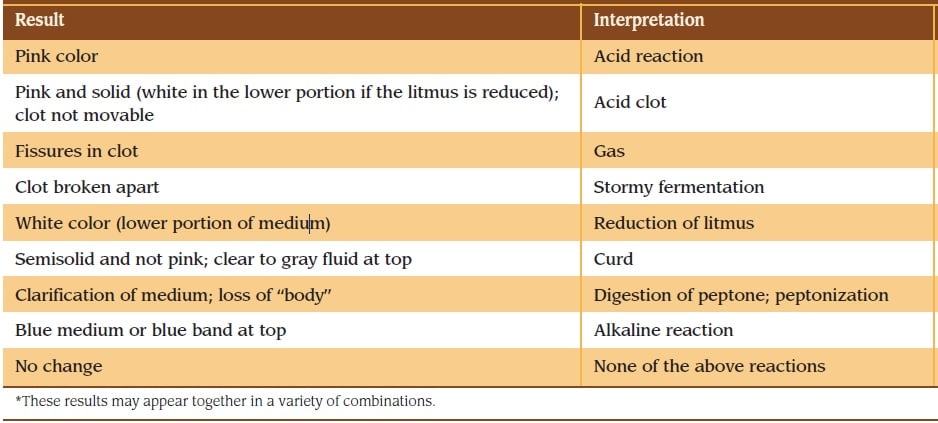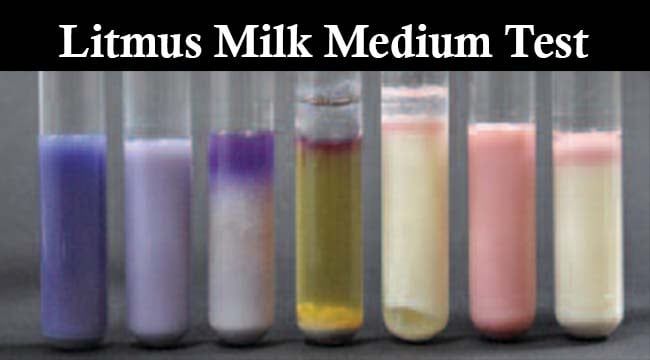Interesting Science Videos
Objective of Litmus Milk Medium Test
- To differentiate microorganisms based on various metabolic reactions in litmus milk, including fermentation, reduction, clot formation, digestion, and the formation of gas.
- Litmus Milk is used primarily to differentiate members within the genus Clostridium.
- It differentiates Enterobacteriaceae from other Gram-negative bacilli based on the ability of enterics to reduce litmus.
- Litmus Milk also is used to cultivate and maintain cultures of lactic acid bacteria.
Principle of Litmus Milk Medium Test
Milk is an excellent medium for the growth of microorganisms because it contains milk protein casein, sugar lactose, vitamins, minerals, and water. Litmus, a pH indicator is incorporated in the medium for the detection of production of acid or alkali and oxidation-reduction activities. Fermentation of lactose in milk with the production of lactic acid is demonstrated when the litmus turns from blue to pink as a result of acid production. The accumulation of acid acts on casein, resulting in the formation of clots due to the precipitation of casein as calcium caseinate. With some organisms, the curd shrinks, and whey is formed at the surface. Acid curd is identified by the clot which remains immobile when the tube is inverted. Some bacteria produce rennin enzymes that act on casein and in presence of calcium ions form paracaseinate that is insoluble and is called rennet curd. Unlike acid curd, it is a semisolid clot that will flow slowly on tilting the tube. Some bacteria possess proteolytic enzyme caseinase and hydrolyze casein. Casein hydrolysis results in the release of large quantities of ammonia that makes the medium alkaline with a foul smell, the litmus turns into a purplish-blue. With further incubation, an opaque clearing of milk occurs as the casein is hydrolyzed to peptides and amino acids. The opaque liquid supernatant which is a whey-like appearance turns brown in color. Additionally, some organisms reduce litmus, in which case the medium becomes colorless in the bottom of the tube.
Media for Litmus Milk Medium Test
Powdered skim milk (100 g), litmus (0.5 g), sodium sulphite (0.5 g), per 1000 mL, pH 6.8.
Procedure of Litmus Milk Medium Test
- Inoculate litmus milk medium with 4 drops of a 24-hour broth culture.
- Incubate at 37°C in ambient air for 24-48 hours.
- Observe daily for 7 days for alkaline reaction (litmus turns blue), acid reaction (litmus turns pink), indicator reduction, acid clot, rennet clot, and peptonization.
- Multiple changes can occur over the observation period and record all changes.
Result Interpretation of Litmus Milk Medium Test

Positive test
Acid pH: pink to red color
Alkaline pH: purplish-blue color
Reduction: white
Acid curd: hard curd with clear supernatant (whey)
Digestion: Dissolution of the clot with clear, grayish, watery fluid and a shrunken, insoluble pink clot
Rennet curd: soft curd followed by peptonization (alkaline pH, supernatant brown)
Gas production: bubbles in coagulated milk
Negative test: color and consistency remain the same

Limitation of Litmus Milk Medium Test
Litmus media reactions are not specific and should be followed up with additional tests for the definitive identification of microorganisms.
Quality control of Litmus Milk Medium Test
Fermentation: Clostridium perfringens (ATCC13124) — gas production
Acid: Lactobacillus acidophilus (ATCC11506) — clot formation
Peptonization: Pseudomonas aeruginosa (ATCC27853) — clearing

thanks very much about your explanation.